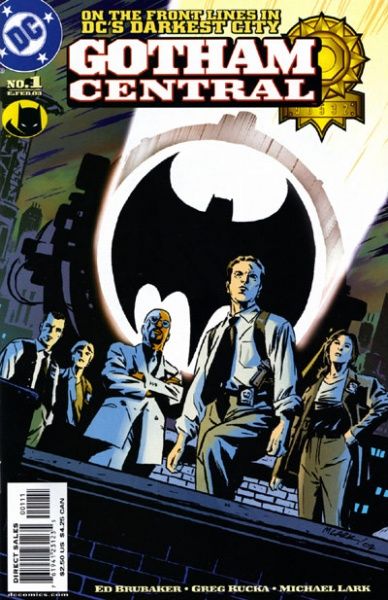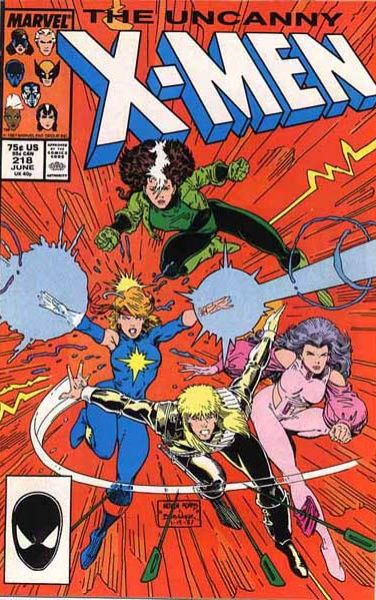Here are the next five! Remember, this is all based on a vote by almost 700 people, who chose their favorite runs, and now I'm revealing the results!
Enjoy!
74 (tie). Greg Rucka and Ed Brubaker's Gotham Central - 122 (1 first place vote)
Gotham Central #1-40
Chuck Dixon featured the Gotham police department quite a lot in his Batman comics, and Doug Moench has a soft spot for both Harvey Bullock and Commissioner Gordon, but even compared to them, Greg Rucka seemed to have an uncanny interest in the Gotham police department. His level of interest was equaled by incoming Batman writer (Rucka wrote Detective Comics), Ed Brubaker, who also specialized in the sort of down-to-Earth police stories that also interested Rucka.
Therefore, after a storyline about the Gotham police department (where Commissioner Gordon is almost killed), the pair launched the acclaimed police procedural, Gotham Central.
The book had an intriguing concept - while the two writers would work together, mostly, it would split the book into a "night" shift and a "day" shift, and each writer would handle a shift. The book was ably drawn by the great Michael Lark.
The book gave readers insight into what it would be like to work in the police department of a city that is mostly known for needing a dude dressed as a bat to help stop crime. As you might imagine, it gets a bit galling.
The book was filled with nice characterizations (Bullock, excepted, of course) and intriguing mysteries and drama.
Lark departed the book with #25, but due to artist Stefano Gaudiano staying on, the new penciler, Kano, was inked in such a way that the book maintained a high level of art quality.
Brubaker departed with issue #36, and rather than carry on all by himself, Rucka decided to close shop with issue #40.
Brubaker and Lark later went to work together on a memorable Daredevil run (that is still ongoing), and Rucka is set to co-write an arc very soon! The band is back together!!
74 (tie). Chris Claremont and Alan Davis' Excalibur - 122 (3 first place votes)
Excalibur #1-24, 42-52, 54-58, 61-67
Okay, this is the trickiest one for me, as most of the votes I got either said "Alan Davis' Excalibur" or "Claremont/Davis' Excalibur," which could both mean the first run or they could mean the second run and the first run, respectively, ya know? VERY few specified that they meant Davis' second run, so rather than guess what each person meant, I figured I'd just count it all as one run, which I really think is fair, as the the book basically became "fill-ins 'r' us" between Davis leaving the book and his return, so I think I am safe crediting all of Davis' Excalibur here as one run. If a lot of people specified they meant ONLY Davis' second run, then maybe I'd do it otherwise, but, well, they didn't, so here it is - Alan Davis' Excalibur!
Excalibur began when Chris Claremont and Alan Davis, both former Captain Britain creators, brought over a few X-Men transplants, Nightcrawler, Kitty Pryde and Rachel Summers, and had them end up in England, where they teamed up with Captain Britain and Captain Britain's special lady friend, Meggan, in forming the superhero team, Excalibur.
Claremont and Davis clearly had a great deal of fun with the title, as it was much more of a humor book than the other X-Books of the time, with the highlight coming in the monumental Cross-Time Caper, which sent the team through a series of alternate universes, in one of the longest storylines this side of Dave Sim.
After the Cross-Time Caper, Davis left the book for a year (and Claremont did only about half the stories in that year), and then Davis came back and wrote and drew the book for another twenty or so issues, also bringing the trademark fun of the early Claremont/Davis issues. That's also why I don't feel too bad counting this as one run, as it really just feels like a continuation of the Claremont/Davis issues, which is why I think most voters just said "Alan Davis' Excalbur."
73. Christopher Priest's Black Panther - 130 (4 first place votes)
Black Panther Vol. 2 #1-62
Kevin Smith and Joe Quesada's Daredevil was certainly the most eye-catching of all the Marvel Knights revamps of the late 90s, but it was Christopher Priest's Black Panther that was the underrated success of the group.
Priest's clever revamp of Panther was built around the concept of introducing a character named Everett Ross, who was sent to Black Panther as a State Department attorney. The creation of Ross, one of the best POV characters out there, allowed Priest to truly play up the almost Batman-like nature of Black Panther, for as distant and Machiavellian as T'Challa might seem, the book always had Ross to ground it in reality (usually with a greet deal of humor, which Priest is quite good at doing).
Priest transformed Panther's book into a hotbed of political intrigue, especially one notable storyline where Panther has to negotiate with Namor, Magneto AND Dr. Doom to avery a possible World War.
In Black Panther, dialogue and characterization was the key, not action, although there was plenty of that. Under Priest, Panther's brilliance and his strength became more pronounced - no more was Panther a background character - Priest made him a major player in the Marvel Universe.
A variety of artists worked with Priest during this run, starting with Mark Texeira and Mike Manley, but probably most notably, Sal Velluto and Bob Almond, who, I believe, are responsible for the most issues of Black Panther drawn than ANY other art team!
In a desperate gambit to keep the book from cancellation (as it was never a particularly high-selling comic), Priest spent the last year or so of the book introducing a NEW character as the Black Panther, a New York cop who had taken a Black Panther costume he had found and used it to fight crime in New York, before ultimately taking the name of White Tiger (and starring in the short-lived Priest follow-up series, The Crew).
71 (tie). Chris Claremont and Paul Smith's Uncanny X-Men - 133 (1 first place vote)
Uncanny X-Men #165-170, 172-175
For the first 70 or so issues of Chris Claremont's Uncanny X-Men, the book had only two artists, Dave Cockrum and John Byrne, and following up Byrne's run was sidestepped by bringing back the artist who had PRECEDED Byrne, Cockrum. So when a new artist was needed, for a book that was slowly becoming one of Marvel's biggest sellers (although not yet AT that point), it was a good gig, but a scary one.
So in stepped Paul Smith, and by the time he left, just ten issues after he joined, Uncanny X-Men was definitively Marvel's biggest superhero comic book.
Smith's biggest strength was probably his biggest weakness, as well, which was his great attention to detail - his books were filled with such detail, that every emotion on every character was just bursting off the page - that you can understand how doing each issue like that, just throwing his whole self into the production, would take its toll on him.
And lucky for Smith, Claremont wrote a number of brilliant scripts during this run that took advantage of Smith's penchant for characterization, most specifically the storyline of Wolverine's marriage, which is PROBABLY the most acclaimed story Claremont wrote for Uncanny X-Men outside of the Byrne run. Such an amazing story, filled with rich character moments as well as Smith's beautiful art, which Claremont, to his credit, used to great effect (there are a number of practically mute scenes during the storyline).
As I mentioned in the entry for John Romita Jr.'s run, when Romita took over from Smith, he had big shoes to fill.
71 (tie). Chris Claremont and Marc Silvestri's Uncanny X-Men - 133 (3 first place votes)
Uncanny X-Men #218, 220-222, 224-227, 229-230, 232-234, 236, 238-244, 246-247, 249-251, 253-255, 259-261
By the time Marc Silvestri took over as regular artist on Uncanny X-Men, the X-Books were, well, "the X-Books," which was not the case for when Byrne and Smith took over. This was not just a comic book, this was a FRANCHISE, and Silvestri, not yet 30 years old, was being given a chance to draw the main book of the franchise.
Its interesting, I always thought of this time period as the Silvestri/Leonardi run of Uncanny X-Men, as they had a deal where artist Rich Leonardi would draw the issues Silvestri didn't, so as to give Silvestri a break, as you can tell from the above list of titles, Silvestri did not often draw a lot of books in a row. HOWEVER, while Silvestri did not draw a lot of issues in a row, he was quite clearly THE penciler during this time period, drawing the vast majority of the issues during his tenure on the book from #218-261.
Silvestri used a different style back then then the one he would develop working for Image in the early 90s. On Uncanny, his art was a great deal more experimental, it seemed almost reminiscent of the work Mazzucchelli was doing on Daredevil around the same time.
This was the time when the Fall of Mutants occurred, and the world thought that the X-Men were dead, but instead, they went and lived in Australia for awhile. Then Inferno happened, and then the X-Men broke up and there was a long storyline where the group slowly got back together. By this time, Silvestri had left the book to begin a popular run on Wolverine with Larry Hama.






